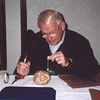This is an example of Venus volcanism.
Click on image for full size
NASA/JPL
Volcanic Rises
Volcanic rises are more like islands than a continents. They are broad, sloping highlands over 1000 km across. They are cut by deep troughs 100-200 km across and have shield volcanoes near the top. Measurements suggest that there is hot magma deep beneath these rises that helps to buoy them up and support their mountains, as shown in this picture.
You might also be interested in:

During its earliest history, Mars was hit with many asteroid-like boulders. The impacts of these boulders caused Mars to become warm enough for continents to drift across the surface just as they do on
...more
AU stands for Astronomical Units. It is an easy way to measure large distances in space. It is the distance between the Earth and the Sun, which is about 93 million miles. For really big distances, we
...more
The solar wind is formed as the Sun's top layer blows off into space. It carries magnetic fields still attached to the Sun. Streams appear to flow into space as if they are spiraling out from the Sun,
...more
For a planet to be affected by a blob of material being ejected by the sun, the planet must be in the path of the blob, as shown in this picture. The Earth and its magnetosphere are shown in the bottom
...more
If someone says they saw an aurora, you might picture something like this. There is another type of aurora that we can't see. These aurora are called SAR arcs. The SAR stands for Stable Auroral Red. That
...more
This figure shows the effect of the aurora on the atmosphere. When FAC's enter the atmosphere and create the aurora, they heat the atmosphere suddenly and abruptly. This creates an impulse which travels
...more
This picture shows the flowing of particles into and out of the auroral zone, as Field-Aligned currents (FAC's) take at short-cut through the atmosphere. Some of the particles entering the auroral zone
...more















